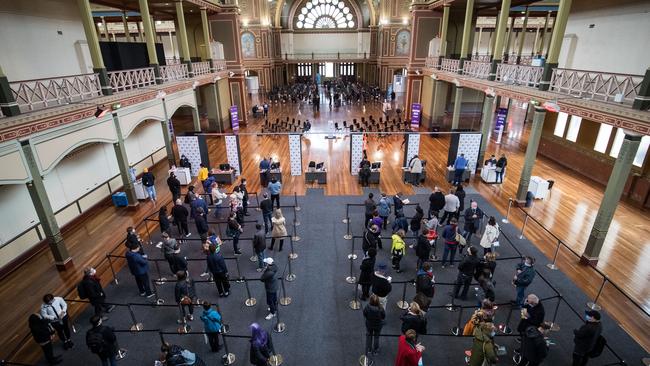Let’s own up to our mistakes on Covid before it’s too late
Just because one state has shown it can manage infections and hotel quarantine, is it best practice to assume another can do the same?
Even by global standards it is starting to look and feel like a debilitating sentence. Lockdown 4.0 will run, it seems, for a minimum of seven days and, despite some pretty alarming numbers during the week, the experts have been buoyed by the latest statistics, early as they are in the campaign.
A relatively small number of four new locally acquired cases was announced on Friday, on the back of a record 47,462 tests.
“I am pretty chipper,” said Melbourne University epidemiologist Tony Blakely.
Victorian chief health officer Brett Sutton was a touch more cautious, noting that “four was better than 10” but warning it would be days before a clear picture emerged.
Both professors are right. The record testing has underpinned the extent to which Melburnians are finally on to the task of defeating the virus.
The public and political battle is essentially being fought on two levels. The first is through the daily briefings conducted by the premier of the day and the health bureaucracy, where the minutia of pandemic life is fundamentally torn apart, drilling into the ins and outs of the government response and forecasts.
The full story runs, however, much deeper than the daily briefing, which in many ways also acts as something of a political distraction, enabling the Victorian government to massage their messaging and steer the debate away from what matters most.
The big picture always hangs above these briefings.
Acting Premier James Merlino has fundamentally sought to shift the blame for the latest outbreak, which emanated from South Australian hotel quarantine, stressing that Victoria would not be on its knees if vaccine rates were higher and there was an alternative to the hotel quarantine system.
He is essentially right, but the argument is more nuanced than he is presenting. For the big picture in this pandemic is unkind to pretty much every key player, with the country urgently needing to take collective responsibility for the imperfect collective response. The latest breakout has in so many ways been entirely predictable and inevitable, having been thrust on the community for three broad reasons.
The first is the refusal by Canberra for so many months to accept that the nation’s hotel quarantine system is broken and will continue to be the conduit for breakouts, particularly while Australia is largely unvaccinated.
Second, that the vaccine rollout has been too slow, marred by limited offshore supply, sclerotic distribution systems for the aged and disabled and community hesitancy fuelled overwhelmingly by ignorance with a dash of complacency.

Third, Victoria’s hopeless QR system and underwhelming health bureaucracy has helped deliver bad outcomes for the community, making it the standout worst performer in the country. Its woes have been exacerbated by a community that eventually refused to fully comply with basic QR contact tracing and reacted to the end of the previous 111-day lockdown by pretending everything had returned to normal. Which it never really did.
Blakely notes that contact tracing in Victoria during Lockdown 4.0 has been “phenomenal”, but adds that there has been a significant policy failure on two levels. This includes the slow response to providing alternatives to hotel quarantine and the slow vaccination of priority populations such as the aged and disabled.
He is less critical of the initial vaccine supply problems, which have been in most ways out of the control of Canberra, but cautions that the hotel quarantine system needs to be reformed.
“It’s a black mark, so let’s just get on with it,” he told Inquirer.
Momentum is now shifting towards a substantial quarantine facility to be built on commonwealth land at Avalon, near Geelong. The project will probably now happen but not be finished for many, many months. Possibly when it’s too late. If Canberra had acted earlier this year, it could, if it had adopted a war-footing approach, be close to finishing it, dramatically reducing the risks to the community. The growing expert opinion is that there should be similar facilities away from cities in each major state and territory, a policy that is now backed by federal Labor.
Jeff Kennett, the former Liberal premier, is deeply worried about the state of Victoria, like so many parents and grandparents; he points out the absurdity of the Victorian parliament only this week joining up to the official state QR code system, having previously used its own.
There were a ridiculous 16 third-party QR systems running in Victoria, which meant that users were confronting myriad systems that were often clumsy and time-consuming. They acted as profound disincentives. The systems compare starkly with NSW.
Kennett also believes that Labor’s dominance of state politics since 1999 (for all but four years) has meant the bureaucracy has become politicised, watering down its ability to deal with such a large-scale crisis. Kennett blames this dynamic on the controlling nature of Premier Daniel Andrews, who remains off work with a serious back injury.
“We are now seeing the outcome of where that control has weakened the system,” Kennett says.
Bill Shorten, the former federal Labor leader and rusted-on Victorian, laments, conversely, the failure of Canberra to ensure that the disabled were not fully vaccinated months ago.
“It is a kick in the guts. The reality is that Covid has never stopped for people with disabilities,” Shorten says.
Nor has it stopped for business, which will be hammered again by the shutdown, many people struggling to hang on. In some ways, Victoria feels like it did at the darkest days of the Cain-Kirner governments in the early 1990s. Australian Industry Group chief executive Innes Willox warned on Friday that Melbourne’s lockdown would cost Victoria somewhere north of $2 billion.
“That’s a huge hit to the economy, to business confidence,” Willox said. “We’ve always argued that lockdowns should be targeted and proportionate and it’s hard to think locking down a state this quick was necessary, but that’s the call they’ve made.”
Perhaps the bigger, unspoken political problem is the insistence that the virus fight be viewed through the prism of NSW’s undoubted success. It’s clear that NSW has had a much more successful campaign compared with Victoria; no one is debating this, particularly after Lockdown 4.0. But is it best practice to assume that just because one state can manage infections and hotel quarantine, that another can necessarily do the same? Especially if the evidence is that they can’t.
It might be why Labor leader Anthony Albanese was on social media on Friday promising: “I would build purpose-built quarantine facilities in every state and territory.”
The policy, while not perfect, at least draws the necessary line in the sand. Especially given many epidemiologists believe the virus in its various forms will be with us for years.
Contact tracers, meanwhile, are furiously trying to track down patrons at five pubs and clubs across Melbourne. It is most unlikely that every patron signed into the QR systems and most unlikely there was aggressive social distancing in every venue. That’s not the way these things tend to work.
It’s also probably why Sutton is adopting a cautious approach to the latest infection numbers.
One day at a time, one lockdown at a time.




This weekend marks days 161 and 162 of Victorians in lockdown since the pandemic breached its banks last year and flowed principally through the streets of metropolitan Melbourne.